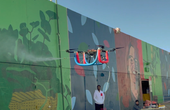ML-Powered SemiAutonomous BionicFlyingFox
The lightweight Flying Fox boasting a water-thin patagium and a motion-tracking system to maneuver on its own
Technical Specifications
| Body Material | 3D Milled Foam |
| Patagium material | Ultralight, wrinkle-free, knitted fabric |
| Motor | 9gm Brushless DC |
| Flight Control | Semi-Autonomous |
| Integrations | Infrared Camera, Communication Mechanisms |
| Net Weight | 580 |
Overview
Structurized for Flying Like a Natural Bat
The BionicFlyingFox is similar to the bat, making it fly like its natural counterpart. The body weight and wing structure give similar kinematics to the artificial bat. The body is made out of 3D milled foam.
Just like Chiroptera, the wing of the robotic model is made of an elastic membrane (two airtight wings and elastane knit) that covers the primaries (outer portions of the wing with the pointed ends) and secondaries (the more significant inner portion of the wing) and is attached to the model’s feet. Moreover, all the articulation points lie on one plane, so the artificial Flying Fox can fold its wings and fly like a natural bat.
Lever Mechanism for Efficient Aerodynamics
The BionicFlyingFox can maintain aerodynamics during flights because of its smartly designed lever mechanism. The wings of the artificial flying fox can move harmoniously without any noticeable shaking. This is because it can activate its primaries and secondaries in any state. To ensure harmony, the primary is attached to the secondary. It moves due to the forced kinematics applied by the secondary unit.
These kinematics are driven by a tiny and lightweight brushless DC motor installed inside the body. It drives the angular gears and the rack-n-pinion gears. The two linear drives attached to the back of the BionicFlyingFox help the wings to fold individually.
Motion-Tracking Mechanism
The flying robotic bat is wirelessly connected to a motion-tracking system that acts like a flight control system used by the aviation industry. When activated, the artificial flying fox starts communicating with the system that keeps tracking its motion and determining its flight path based on the pre-programmed system commands.
The motion-tracking mechanism features two independently movable infrared cameras to detect all the movements of the robotic bat. Every move is saved in the central master computer that analyzes it and sends the following control command to maintain its trajectory.
ML-Powered Semi-Autonomous Flight
The BionicFlyingFox can fly semi-autonomously through machine learning. The model is trained to fly on pre-programmed images. Based on the self-updating control algorithm stored in the central computer, the bionic flying fox learns to maneuver and master it to perfection.
The artificial flying fox can calculate the wing movements independently because of its complex behavior pattern and the onboard electronics. However, the robot needs manual assistance when it starts flying and landing. In between, it flies on autopilot.
Thanks to a lightweight design and flying agility, the BionicFlyingFox provides several applications like aerial surveillance and imaging, etc. It can integrate an infrared camera for night vision and thermal mapping and can potentially bring a new dimension to the manufacturing of semi-autonomous aerial vehicles.










